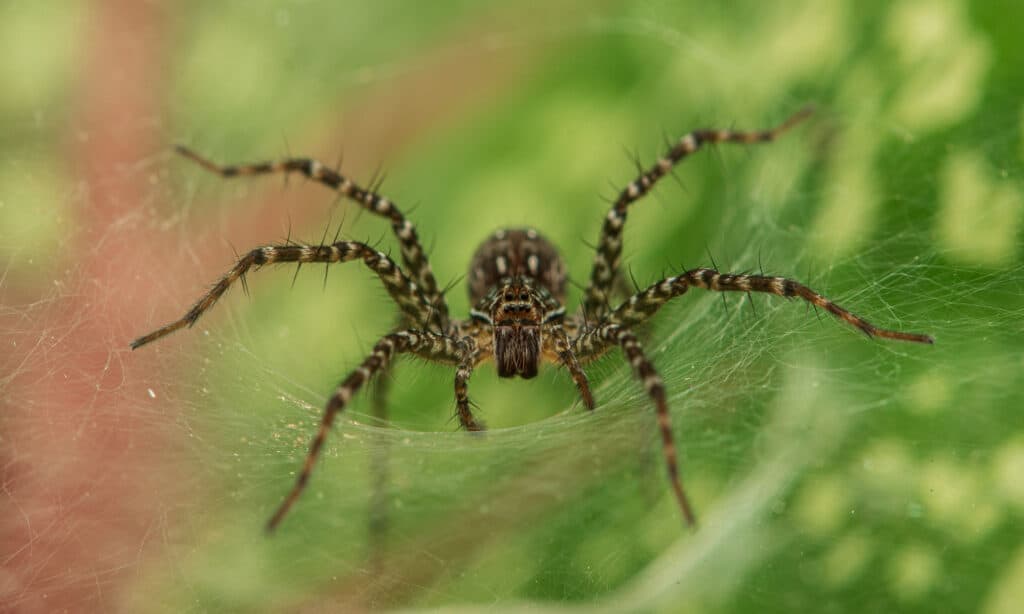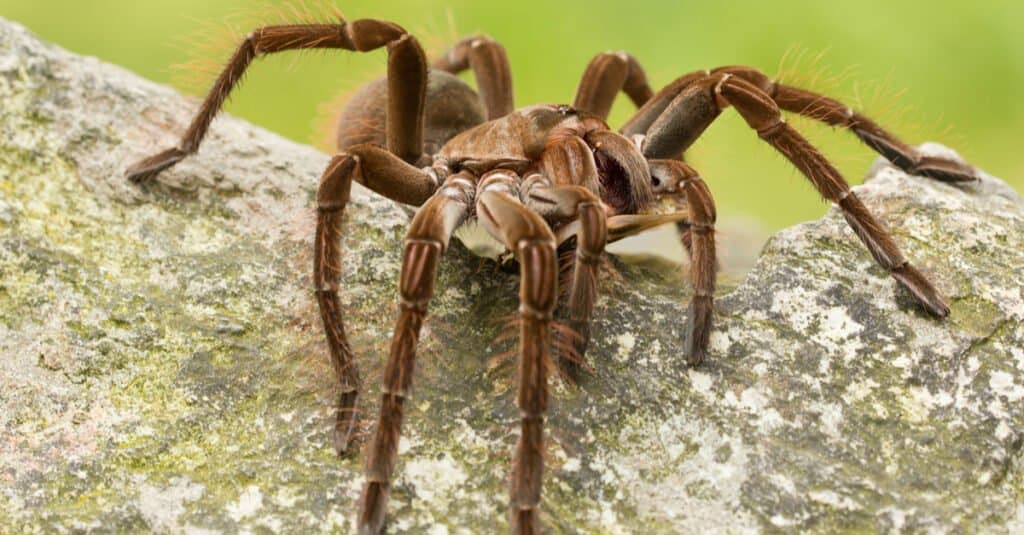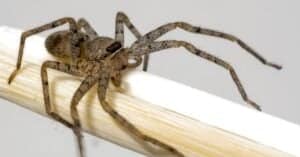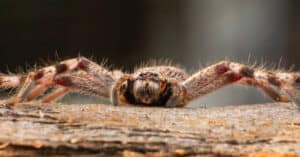Wolf spiders form the Lycosidae family. They’re called this way because they do not spin webs like most spiders to hunt and kill prey but rather chase or ambush them from their burrows. That’s not the only thing that makes them excellent hunters, though! Wolf spiders also have incredible eyesight and a powerful venom paralyzing prey.
Another unique thing about wolf spiders is that they carry their egg sacs attached to their spinnerets.
However, wolf spiders aren’t as large as other arachnids like tarantulas, for instance, when it comes to their size. There are more than 2,800 species of wolf spiders, and almost all are very small! But how big can they get? Keep reading to find out!
What Is the Biggest Wolf Spider Species?

Carolina wolf spiders are the largest in their family.
©Will E. Davis/Shutterstock.com
Hogna carolinensis spiders, commonly called Carolina wolf spiders, are the largest in their family. They are part of the Hogna genus, which includes other large wolf spiders.
Female Carolina wolf spiders grow as large as 0.87-1.38 inches, while males are slightly smaller, reaching 0.7-0.79 inches. However, if we were to count their legs, Carolina wolf spiders’ length could reach 2-3 inches!
Besides being extremely large for a spider, the Carolina wolf spider has another distinctive feature – the orange coloration of males. While females are light brown with dark brown patterns on their backs, males have additional orange coloration on both sides of their abdomens.
Wolf spiders can be found throughout the North American continent. However, if they were to choose a habitat, they’d go for open areas, where they “enjoy” their lives in burrows. If Carolina wolf spiders don’t feel like digging burrows, since they don’t have specialized digging anatomy, they’ll just take over the burrows found on their way. Once they get comfortable in their newly acquired places, they patiently wait for prey to walk past their homes and ambush them.
Here’s another interesting fact about these large spiders! Carolina wolf spiders are among the only wolf spiders with a unique venom that doesn’t only paralyze the prey but also destroys the prey microbes that can infect them!
What Are Other Large Wolf Spiders?
Another large wolf spider species is part of a different genus in the Lycosidae family of wolf spiders. It’s called Tigrosa aspersa or woodland giant wolf spider. It can grow up to one inch and is found in the eastern part of the United States. People often confuse it with another species in the Tigrosa genus called Tigrosa helluo. However, the latter is much smaller, measuring 0.67 inches on average.
Another large wolf spider is the Lycosa aragogi, although there’s only one specimen in the world. An Iranian entomologist discovered it in Iran, in Kerman Province’s southeastern mountainous region. The specimen was collected in 2016 and was later described in the Zootaxa journal for animal taxonomists.
This spider measured 1.02 inches long, almost like a female Carolina wolf spider, and even larger than a male! The Lycosa aragogi wolf spider had a unique pattern on its cephalothorax – two black and three white stripes. Moreover, it had patterns of black and white dots on its abdomen.
Besides, a unique thing about this spider is its name. When you’ve read its scientific classification, you’ve probably instantly thought about Aragog, the famous fictional spider from “Harry Potter,” right?! Well, it’s no coincidence!
This spider was named after Aragog because it resembled its puppet version from “Harry Potter and the Chamber of Secrets.” Moreover, a year after its discovery, in 2017, the world celebrated its 20th Harry Potter anniversary. Another reason may be that the Lycosa aragogi specimen was found on the 26th of April 2016, while Aragog died 19 years earlier, on the 20th of April, according to J.K. Rowling’s story.
Are Wolf Spiders Dangerous?

Wolf spiders have venom, but it isn’t strong enough to harm humans.
©Vijin Varghese/Shutterstock.com
While wolf spiders have venom, it isn’t strong enough to harm humans. Even though they don’t have the most welcoming appearance, wolf spiders are shy creatures that will choose to freeze or run away from humans rather than bite them. They’ll resort to biting only if threatened or cornered and if they have nowhere to run. However, if a wolf spider bites you, the wound will probably hurt for a while, and the bite spot may swell or itch.
The pain lasts only a few minutes, while the swelling and itching may last a few days. On the other hand, allergic people may develop more severe reactions. In this case, they need to seek medical attention.
Sources officially verified by doctors say that if a wolf spider has bitten you and the pain and swelling don’t fade away, you should seek medical care. Moreover, if you develop headaches, feel dizzy, or experience nausea, fever, or weakness, a doctor needs to see you.
Since people often get bitten by wolf spiders and don’t even notice it, as they’re pretty small, you must know that wolf spider bites leave two marks on the skin. The wound will be red and swollen. If you aren’t sure what spider bit you or whether it was a spider, we recommend checking with your doctor.
What Is the Biggest Spider on Earth?

The Goliath birdeater, scientifically called
Theraphosa blondi,is the world’s largest spider.
©Milan Zygmunt/Shutterstock.com
The Goliath birdeater, scientifically called Theraphosa blondi, is the world’s largest spider! It’s a tarantula in the Theraphosidae family and inhabits northern South America. Goliath birdeaters have a body length of up to 5.1 inches. Just imagine how large they are compared to Carolina wolf spiders, which rarely grow larger than 1.5 inches long! Moreover, they have a leg span of up to 12 inches and can weigh up to 6.2 ounces, while Carolina wolf spiders usually weigh up to an ounce.
Since Goliath birdeaters feed on worms, amphibians, and other arthropods (yes, they rarely or never feed on birds, despite their names), they can easily devour a large Carolina wolf spider! They can even hunt, kill, and eat rodents, frogs, and snakes!
Up Next:
- Are Wolf Spiders Poisonous or Dangerous?
- Are Wolf Spiders Dangerous to Dogs or Cats?
- Wolf Spider Location: Where Do Wolf Spiders Live?
- Wolf Spider Lifespan: How Long Do Wolf Spiders Live?
The photo featured at the top of this post is © iStock.com/CathyKeifer
Sources
- Spider Identifications, Available here: https://spideridentifications.com/carolina-wolf-spider.html
- iNaturalist, Available here: https://www.inaturalist.org/taxa/122621-Hogna-carolinensis
- iNaturalist, Available here: https://inaturalist.ca/taxa/455062-Tigrosa-aspersa
Thank you for reading! Have some feedback for us? Contact the AZ Animals editorial team.






